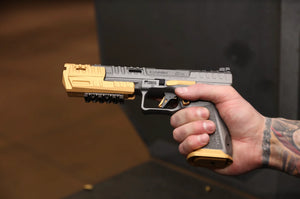As firearm enthusiasts delve deeper into the world of shooting and marksmanship, understanding the mechanics and accessories that enhance the performance of their pistols becomes paramount. One such accessory, often the topic of spirited discussions, is the pistol compensator. But what exactly is a pistol compensator, and how does a compensator work?
At its core, the primary pistol compensator's purpose is to reduce significant amounts of recoil and help manage the muzzle rise that occurs after the firearm is discharged. This function is achieved by strategically placed ports that divert the explosive gasses released during shooting, using counteracting the pistols inherent recoil. . As we explore the various aspects of selecting the perfect pistol compensator, we'll uncover the intricacies of their operation, benefits, drawbacks, and much more, providing a comprehensive guide for both novice shooters and seasoned marksmen alike.
Understanding the Mechanics of Pistol Recoil
Physics behind gun recoil
Every action has an equal and opposite reaction. This principle, rooted in Newton's third law of motion, is vividly evident in the recoil experienced when firing a pistol. As the bullet is propelled forward with great force, the gun itself is pushed back with equivalent force into the shooter's hand or shoulder. This reactionary force is what we commonly refer to as recoil. It's essential for any shooter, whether novice or expert, to comprehend this basic principle and learn how to manage this energy to improve their shooting accuracy and overall experience.
Newton's third law of motion
Sir Isaac Newton, a legendary physicist, postulated a simple yet profound concept: For every action, there is an equal and opposite reaction. When applied to firearms, this means that the explosive force driving the bullet forward will also push the firearm backward. This backward force, felt by the shooter, is what's known as recoil. Understanding Newton's third law is pivotal for shooters, as it underscores the very nature of how firearms operate and why recoil management techniques, like using a compensator, are beneficial.
Muzzle rise and its implications on shooting accuracy
When a pistol is fired, the force doesn't merely push the gun straight back. Because of the pistol's design and the shooter's grip, this force often causes the muzzle, or the front end of the pistol, to rise. This phenomenon is termed "muzzle rise" or "muzzle flip." Excessive muzzle rise can significantly hinder shooting accuracy, especially during rapid fire, as it requires the shooter to constantly re-acquire the target or front sight. It's this challenge that many shooting accessories, like compensators, aim to address, ensuring that consecutive shots remain on target.
How compensators work
The magic behind a pistol compensator's effectiveness lies in its ability to harness and redirect the propellant gasses released during firing. Instead of allowing these gasses to exit the barrel in all directions, the compensator channels them in specific vectors, counteracting some of the forces that cause recoil and muzzle rise.
Redirecting propellant gasses
When a bullet is fired, it's not just the projectile that races out of the muzzle; a rush of hot propellant gasses follows it. These gasses, if left unchecked, contribute to the pistol's recoil and muzzle flip. A compensator, strategically designed with ports and chambers, captures these gasses and directs them upwards and sometimes sideways. By doing so, the upward thrust of these gasses counteracts the natural muzzle rise, leading to a more stable shooting experience.
Reducing muzzle climb and felt recoil
While muzzle rise is the upward movement of the pistol's muzzle, "felt recoil" is the shooter's subjective experience of the gun's backward push. Compensators, by redirecting propellant gasses, can significantly reduce both these phenomena. As the gasses push upwards through the compensator's ports, they create a downward force on the pistol, diminishing muzzle climb. Simultaneously, by dispersing these gasses more effectively, the sharpness of the recoil, or its 'jolt', is also lessened. This results in not only a more accurate shot but also a more comfortable shooting experience.
Key Considerations in Selecting a Pistol Compensator
Compatibility
- Not all compensators are universal. It's crucial to choose one specifically designed for your pistol's make and model.
- Some brands offer pistol-specific compensators, ensuring seamless integration and optimal performance.
- 45Blast compensators are currently designed for a 9mm pistol that will not work any caliber larger than 9mm.
Material and construction
- Steel vs. aluminum:
- Steel compensators are durable but heavier. They're suitable for high-caliber pistols where more weight might actually help manage recoil.
- Aluminum offers a balance between weight and strength, making it a popular choice.
- Durability and weight implications:
- Heavier compensators might change the balance of your pistol, impacting its point of aim.
- Consider the trade-off between durability and added weight to find what suits your shooting style.
Design and gas port configuration
- Single-chamber vs. multi-chamber:
- Single-chamber compensators are compact but do not manage recoil as effectively as multi-chamber designs.
- Multi-chamber compensators have more space to redirect gasses, leading to superior recoil management at the cost of length and weight.
- Top-ported vs. side-ported:
- Top-ported designs primarily address muzzle rise by directing gasses upwards.
- Side-ported compensators distribute gasses to the sides, helping reduce both recoil and muzzle flip.
Size and dimensions
- Length, width, and height considerations:
- A longer compensator might offer better recoil management but can make the pistol bulkier.
- Ensure the compensator doesn't interfere with your sight picture or holstering.
- Impact on overall pistol balance:
- Adding a compensator changes the pistol's weight distribution. Testing different sizes can help find what feels most comfortable and balanced.
Installation requirements
- Threaded vs. non-threaded barrels:
- Compensators typically require threaded barrels for installation.
- Some compensators might clamp onto the barrel, suitable for non-threaded models, but ensure they offer a secure fit.
- Need for gunsmithing or DIY options:
- Some compensators might require professional installation to ensure safety and performance.
- Others might offer easy DIY installation, but always refer to manufacturer instructions and safety guidelines.
Aesthetics
- Matching the compensator's style with the pistol:
- While function is paramount, many shooters also care about their pistol's appearance.
- Choose a compensator design that complements your firearm's aesthetics, ensuring it looks as good as it performs.
- Personal preferences and customization options:
- Some brands offer customizable color options or designs.
- Whether it's a unique finish or a specific engraving, select a compensator that aligns with your personal style.
Benefits of Using a Compensator
The decision to equip a pistol with a compensator often stems from the desire to enhance shooting performance and comfort. While some purists might prefer the raw, unaltered experience of firing a gun, many shooters have discovered the tangible advantages that a compensator offers. Let's explore these benefits in detail:
Improved shooting accuracy: One of the primary benefits of using a compensator is the noticeable improvement in shooting accuracy. By reducing muzzle rise, the shooter can maintain a consistent sight picture even during rapid fire. This consistency allows for quicker target acquisition after each shot and promotes tighter groupings on the target.
Faster follow-up shots: In scenarios like competitive shooting or self-defense, milliseconds matter. A compensator helps reduce the time between shots, allowing shooters to fire consecutive rounds more swiftly. By controlling the pistol's recoil and muzzle flip, shooters can re-align their sights and prepare for the next shot with enhanced speed.
Reduction in shooter fatigue: Prolonged shooting sessions can be taxing on the hands and arms, especially with high-caliber pistols. The reduced recoil provided by compensators means that shooters experience less physical strain over time. This not only enhances the shooting experience but also allows for longer practice sessions without discomfort.
Enhanced shooting experience: Beyond the tangible benefits of accuracy and speed, a compensator can also elevate the overall joy of shooting. Many enthusiasts find that the managed recoil and reduced muzzle flip give them greater control over their firearm, leading to a more confident and pleasurable shooting experience.
Safety and control: While a compensator's primary function is to enhance performance, it indirectly contributes to safety as well. By giving shooters better control over their pistol, there's a reduced chance of accidental discharges due to flinching or overcompensating for recoil. A well-controlled firearm is a safer firearm.
Installing and Maintaining a Pistol Compensator
Installing a pistol compensator is a process that demands precision and safety. Before diving into the installation, it's imperative to consult the manufacturer's guide that comes with your chosen compensator. These instructions offer invaluable insights tailored to the specific model you've selected. As a fundamental safety measure, always start by ensuring your pistol is unloaded, with the chamber cleared and the magazine removed. Gather the necessary tools in advance, as some compensators might require specialized equipment for a flawless fit.
When attaching the compensator, especially if it screws onto a threaded barrel, be cautious not to cross-thread or over-tighten. Such mistakes could potentially damage both your barrel and the compensator. After installation, a quick check for proper alignment ensures that the compensator's ports are correctly positioned for optimal performance.
Maintaining your compensator is just as crucial as its installation. Given that compensators deal directly with the residue from propellant gasses, regular cleaning is essential to maintain their efficacy. While many general gun-cleaning solvents might suffice, some solvents are designed explicitly for compensators, breaking down stubborn carbon build-ups more effectively. Over time, the rigors of shooting can lead to wear on your compensator. It's advisable to inspect it regularly for any signs of damage or wear. Also, periodically ensure that the compensator remains tightly attached, as the intense forces during firing can sometimes cause them to loosen.
Safety is paramount throughout both installation and maintenance. Always don protective eyewear to safeguard against potential debris or chemicals. Resist the temptation to modify a compensator; such changes can compromise both its safety and functionality. Finally, a routine check for obstructions in the compensator's ports ensures it operates safely and effectively every time you shoot.
Wrapping Up
Pistol compensators have gained immense popularity for good reasons. They offer a myriad of benefits, such as enhanced accuracy, quicker follow-up shots, and a more enjoyable shooting experience. But as we've delved into throughout this guide, understanding the mechanics behind their operation and the nuances in selecting the right one are foundational.
However, beyond the technicalities and the wide array of options lies an individual shooter's unique needs and preferences. While this guide aims to equip you with a broad knowledge base, your personal experience is invaluable. Balancing technical advice with what feels right for you will lead to the best decision.
Venturing into the world of pistol compensators might seem daunting, but remember: the shooting community is vast and supportive. Seeking advice from seasoned experts, engaging in discussions on shooting forums, or trying out multiple compensators at a range can be immensely helpful. With patience, information, and a bit of hands-on experience, you're sure to find the perfect compensator that aligns with your shooting style and needs.


